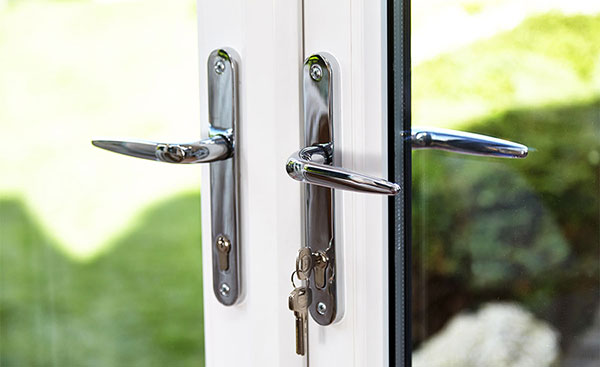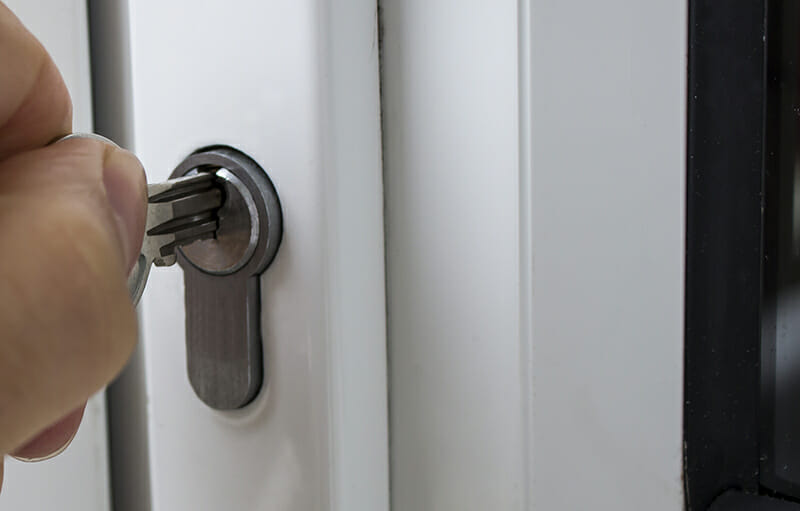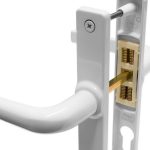
UPVC Door Handle Won’t Lift Up to Lock or Go Down – Price to Fix & Why
If your UPVC door handle won’t lift up to lock or go down, it can be frustrating and potentially compromise the security of your home. However, there are solutions that can help you fix this issue without breaking the bank.
Reasons for a malfunctioning UPVC door handle:
1. Loose screws: Check if the screws holding the handle in place are loose. Tighten them properly to see if it resolves the problem.
2. Worn out spindle: The spindle that connects the handle to the locking mechanism may have worn out over time. This can prevent the handle from lifting up or going down. In such cases, you may need to replace the spindle.
3. Damaged locking mechanism: The locking mechanism itself may be damaged, preventing the handle from functioning properly. In this case, you may need to replace the locking mechanism.
Costs of fixing a UPVC door handle:
The cost of fixing a UPVC door handle can vary depending on the extent of the problem and the materials needed. If it’s a simple fix like tightening loose screws, you can do it yourself without any additional cost. However, if you need to replace the spindle or the locking mechanism, you may incur additional costs for the parts and labor.
It’s important to address a malfunctioning UPVC door handle as soon as possible to ensure the security and functionality of your door. If you’re unsure about how to fix the issue yourself, it’s recommended to consult a professional who can provide expert advice and assistance.
The problem
The problem with a UPVC door handle that won’t lift up to lock or go down can be quite frustrating. This issue prevents the door from latching properly and compromises the security of your home or property.
There are a few common reasons why this problem occurs:
- The lock mechanism is jammed or stuck, preventing the handle from operating smoothly.
- There is a misalignment between the handle and the locking mechanism, causing difficulty in lifting or lowering the handle.
- The handle itself may be damaged or worn out, making it difficult to engage the lock properly.
Regardless of the specific cause, it is important to fix this issue as soon as possible to ensure the safety and security of your premises.
Importance of fixing the UPVC door handle
The lock on your UPVC door is crucial for the security of your home or property. If the handle won’t lift up to lock or go down, it can put your property at risk of break-ins or unauthorized access.
A broken or malfunctioning UPVC door handle not only compromises the security of your property but also affects its convenience and functionality. The handle is an essential component that allows you to easily open and close the door, providing access to your home or other spaces.
By fixing the UPVC door handle, you ensure that it functions properly, allowing you to lock and unlock the door effortlessly. This not only provides peace of mind but also prevents any potential inconvenience caused by a faulty handle. You won’t have to struggle with trying to secure your property or worry about not being able to open or close the door smoothly.
Regular maintenance and prompt fixing of the UPVC door handle are essential to prevent further damage and costly repairs. Ignoring a minor issue with the handle can lead to more significant problems down the line, such as complete handle failure or damage to the locking mechanism.
Additionally, fixing the handle promptly can save you money in the long run. The cost of repairing or replacing a broken UPVC door handle is usually less than the expense of dealing with a security breach or a damaged door. It’s a small investment to ensure the continued safety and functionality of your property.
Don’t overlook the importance of fixing a UPVC door handle that won’t lift up to lock or go down. By taking immediate action, you protect your property, enhance convenience, and save money in the process.
Common Causes
The following are common causes for a UPVC door handle that won’t lift up to lock or go down:
1. Loose Fixings: If the handle feels loose or wobbly, it may be due to loose fixings. Check the screws or bolts that hold the handle in place and tighten them if necessary.
2. Misalignment: Misalignment can occur when the UPVC door has shifted or settled over time. This can prevent the handle from operating smoothly. Adjustments may need to be made to realign the door and handle.
3. Damaged Handle: A handle that won’t lift up or go down may be due to internal damage or wear and tear. Inspect the handle for any signs of damage, such as cracks or excessive play. If damaged, the handle may need to be replaced.
4. Faulty Lock Mechanism: The lock mechanism inside the door may be faulty, preventing the handle from lifting up or going down properly. A locksmith or door repair specialist will be able to diagnose and fix any issues with the lock mechanism.
5. Obstruction: There may be an obstruction preventing the handle from moving. This could be due to debris or an object getting stuck in the mechanism. Clear any obstructions and ensure the handle can move freely.
6. Incorrect Installation: If the UPVC door handle was not installed properly, it may not function correctly. Check the installation instructions or consult a professional to ensure the handle is installed correctly.
By addressing these common causes, you can troubleshoot and fix a UPVC door handle that won’t lift up to lock or go down, saving you time and money on potential repairs or replacements.
Worn out springs
One common issue that can cause a UPVC door handle to not lift up to lock or go down is worn out springs. Springs play a vital role in the operation of the handle, providing the necessary tension to lift and lower it smoothly.
Over time, these springs can become worn out due to frequent use, exposure to weather elements, or even normal wear and tear. When the springs lose their tension, it can make it difficult or impossible to lift the handle up to lock or push it down to unlock the door.
To fix this issue, you will need to replace the worn out springs with new ones. This can be done by removing the handle from the door and locating the springs inside. Carefully remove the old springs and replace them with new ones of the same size and tension.
It is important to note that DIY repairs of UPVC door handles can be challenging, especially for someone without prior experience. If you are unsure or uncomfortable with the process, it is recommended to seek professional help to ensure proper installation and functionality.
In summary, worn out springs can contribute to a UPVC door handle that won’t lift up to lock or go down. To fix this issue, you will need to replace the worn out springs with new ones. If you are not confident in your DIY skills, it’s best to call a professional for assistance.
Misaligned locking mechanism
If your UPVC door handle won’t lift up to lock or go down, the issue might lie with a misaligned locking mechanism. The locking mechanism is responsible for securing the door in place when it is locked. If it becomes misaligned, it can prevent the handle from lifting up to lock or going down properly.
To fix a misaligned locking mechanism, you will need to perform the following steps:
|
1. Remove the handle: Start by removing the handle from the door. This can usually be done by unscrewing a few screws located on the inside of the door. Once removed, set the handle aside. |
|
|
2. Adjust the locking mechanism: Locate the locking mechanism inside the door. It is typically a metal rod or a series of metal rods that connect to the handle. Carefully adjust the position of the mechanism so that it aligns with the handle properly. |
|
|
3. Test the handle: Once you have adjusted the locking mechanism, test the handle to make sure it lifts up to lock and goes down smoothly. If the issue persists, you may need to further adjust the mechanism or consult a professional. |
|
|
4. Reinstall the handle: Once you are satisfied with the handle’s functionality, reattach it to the door by screwing it back into place. Make sure all screws are securely tightened to ensure a proper fit. |
|
If you are not comfortable performing these steps yourself or if the issue persists despite your efforts, it is recommended to seek the assistance of a professional locksmith or door repair specialist. They will have the necessary expertise and tools to fix the misaligned locking mechanism and ensure your UPVC door functions properly.
Damaged door handle
A damaged door handle can be a frustrating problem to deal with. If your UPVC door handle won’t lift up to lock or go down, it’s important to fix it as soon as possible to ensure the security of your home.
One common reason for a door handle not functioning properly is wear and tear. Over time, the handle may become loose or the internal mechanisms may become damaged or worn out. In some cases, the handle may even break or become completely stuck.
To fix a damaged door handle, start by inspecting it for any visible signs of damage or wear. If the handle is loose, tighten the screws that hold it in place. If the handle is broken or stuck, you may need to replace it with a new one.
Before purchasing a new handle, make sure to measure the size and style of your existing handle to ensure you buy a compatible replacement. UPVC door handles come in various designs and sizes, so it’s important to choose one that matches your door.
Once you have the new handle, you can begin the replacement process. Start by removing the old handle by unscrewing the screws that hold it in place. Then, carefully attach the new handle, making sure all screws are tightened securely.
If your door handle still won’t lift up to lock or go down after replacing it, there may be an underlying issue with the door itself. In this case, it’s best to consult a professional locksmith or UPVC door specialist who can diagnose and fix the problem.
Remember, a damaged door handle can compromise the security of your home, so it’s important to address the issue promptly. By following these steps, you can fix your UPVC door handle and ensure the safety of your property.
Costs of not fixing the issue
If you neglect to fix a UPVC door handle that won’t lift up to lock or go down, there are several potential costs you may incur:

- Increased risk of security breaches: A faulty handle can make it easier for unauthorized individuals to gain access to your property, putting your belongings and personal safety at risk.
- Higher energy bills: A door that doesn’t fully close or lock properly can allow drafts and heat to escape, leading to increased energy consumption and higher utility bills.
- Potential damage to the door: Continuously forcing a handle that won’t lift up or go down can cause damage to the UPVC door itself, resulting in costly repair or replacement.
- Inconvenience and frustration: Dealing with a handle that won’t function as intended can be incredibly frustrating and time-consuming, as you may need to constantly struggle to secure or open your door.
- Diminished curb appeal: A malfunctioning handle can detract from the overall appearance of your home or property, potentially affecting its value and curb appeal.
It’s important to address any issues with your UPVC door handle promptly to avoid these potential costs and ensure the security and efficiency of your property.
Security risks
A malfunctioning UPVC door handle that won’t go up to lock or go down can pose serious security risks for your property. When your door handle is not functioning properly, it compromises the safety and security of your home or business.
The inability to lock your UPVC door means that anyone can easily gain unauthorized access to your premises. This puts your belongings, valuables, and the well-being of your loved ones or employees at risk.
Fixing the issue promptly is crucial to ensure the security of your property. Ignoring a faulty door handle could potentially invite break-ins, burglaries, or other security breaches.
Whether the handle won’t lift up to lock or go down, it is essential to address the problem immediately. There are various reasons why a UPVC door handle may fail to function correctly, including mechanical issues, loose screws, or damaged hardware.
| 1. Increased vulnerability to break-ins and burglaries |
| 2. Compromised safety of occupants or employees |
| 3. Potential loss of valuable belongings |
| 4. Higher risk of property damage |
| 5. Possible liability for business owners |
By fixing your UPVC door handle promptly, you can reduce the security risks associated with a malfunctioning lock mechanism. It is recommended to seek professional help to diagnose and repair the issue to ensure reliable and durable security for your property.
Remember, a properly functioning door handle is the first line of defense for your property, providing peace of mind and protection against potential threats.
Energy efficiency concerns
In addition to addressing issues such as a UPVC door handle that won’t lift up to lock or go down, fixing these problems can also improve the energy efficiency of your home.
When a UPVC door handle won’t lift up to lock or go down, it can result in gaps and drafts around the door. These gaps allow for air to escape and enter your home, causing your heating or cooling system to work harder to maintain a comfortable temperature. This increased energy usage can lead to higher utility bills and a less energy-efficient home.
By fixing the issue with your UPVC door handle, you can ensure a proper seal and prevent air leakage. This will help to maintain a consistent temperature in your home, reduce drafts, and improve energy efficiency. Additionally, addressing this problem can also enhance the security of your home, as a properly functioning lock offers better protection against potential break-ins.
It’s important to address any issues with your UPVC door handle promptly to prevent further energy loss and potential security risks. Whether the problem is due to a broken mechanism, misalignment, or simply wear and tear, contacting a professional to fix the handle can help maintain the energy efficiency of your home and provide peace of mind.
Inconvenience
The inconvenience of a malfunctioning lock on your UPVC door handle can be frustrating. When the handle won’t go down or lift up to lock, it can be a hassle to secure your home or property. Not being able to properly lock your door can compromise the safety and security of your belongings, leaving you feeling vulnerable.
Not only does a faulty UPVC door handle make it difficult to lock or unlock your door, but it can also create inconveniences in your daily life. For example, if the handle won’t go down to lock, you may find yourself constantly worrying about the security of your home. If the handle won’t lift up to lock, it can be a challenge to open and close the door, making it cumbersome to enter or exit your property.
Fortunately, there are solutions to address these issues. By fixing the UPVC door handle, you can regain the convenience and peace of mind that comes with a properly functioning lock. Whether the problem lies with the mechanism inside the handle or with the alignment of the door itself, there are various techniques and methods available to resolve the issue.
Don’t let a stubborn UPVC door handle inconvenience you any longer. Take the necessary steps to fix the problem and enjoy the ease of a fully functional lock on your door.
DIY Solutions
If your UPVC door handle won’t lift up to lock or go down, there are a few DIY solutions you can try before calling a professional.
First, check if there is any debris or dirt blocking the movement of the handle. Clean the handle and the surrounding area thoroughly with a soft cloth or brush.
If the handle still won’t lift up or go down, try lubricating the mechanism with a silicone-based spray. Spray a small amount into the keyhole and around the handle, then try lifting or lowering the handle again.
If the issue persists, it might be a problem with the internal mechanism or the door alignment. In this case, it is recommended to consult a professional to diagnose and fix the problem.
Remember, trying DIY solutions is a cost-effective option, but if you are not confident in your skills or if the problem persists, it’s always best to seek professional help to ensure your UPVC door handle functions properly and provides the security you need.
Lubricating the handle
One of the common reasons why a UPVC door handle may not lift up to lock or go down is due to lack of lubrication. Over time, the handle can become stiff and difficult to operate, making it frustrating to lock or unlock the door.
To fix this issue, you will need a lubricant specifically designed for UPVC doors. This can be purchased from your local hardware store or online. Before applying the lubricant, make sure to clean the handle and surrounding area with a mild soapy solution.
Once the handle is clean, apply a small amount of lubricant to the moving parts of the handle, such as the inside of the mechanism or any visible joints. Be careful not to over-lubricate, as this can attract dust and dirt, which can further impede the handle’s movement.
After applying the lubricant, try operating the handle to see if it moves more smoothly. If necessary, repeat the lubrication process until the handle moves freely up to lock and goes down without any issues.
Lubricating the handle regularly, at least once every few months, can help prevent future problems and ensure the smooth operation of your UPVC door.
Adjusting the locking mechanism
If your UPVC door handle won’t lift up to lock or go down and lock, the issue may lie with the locking mechanism. Here are some steps to adjust the locking mechanism:
| Step 1: | Check if there is any debris or dirt obstructing the movement of the locking mechanism. Use a cloth or brush to remove any buildup. |
| Step 2: | Inspect the alignment of the handle with the door frame. If the handle is misaligned, it may not engage properly with the locking mechanism. Adjust the handle or door frame as needed. |
| Step 3: | Ensure that the door is properly aligned within the frame. A misaligned door can put extra pressure on the locking mechanism, preventing it from operating smoothly. Adjust the hinges or contact a professional for assistance. |
| Step 4: | Inspect the locking mechanism for any signs of wear or damage. If the mechanism is worn or broken, it may need to be replaced. Contact a professional for further assistance or replacement parts. |
| Step 5: | Apply lubricant to the moving parts of the locking mechanism, such as the handle and the locking bolts. This can help improve the smoothness of the operation. |
By following these steps, you should be able to adjust the locking mechanism of your UPVC door handle, allowing it to lift up to lock or go down without any issues.
Q&A:
What could be causing my UPVC door handle to not lift up to lock?
There are several possible causes for this issue. It could be a problem with the lock mechanism itself, such as a broken or worn-out component. Alternatively, there might be an issue with the alignment of the door, causing the handle to not line up properly with the lock. Another possible cause is a loose or faulty handle that needs to be tightened or replaced.
How much does it cost to fix a UPVC door handle that won’t lift up to lock?
The cost of fixing a UPVC door handle that won’t lift up to lock can vary depending on the specific problem and the professional you hire to fix it. In general, the cost can range from $50 to $200. If the issue is a simple fix, such as tightening a loose handle, it may be on the lower end of the cost range. However, if the problem requires more extensive repairs or replacement of parts, it may be on the higher end of the range.
Can I fix a UPVC door handle that won’t lift up to lock myself?
While some minor issues with a UPVC door handle can be fixed by a homeowner with basic tools and knowledge, it is generally recommended to hire a professional for this type of repair. Working with the lock mechanism and door alignment can be complex, and if not done correctly, it can cause further damage or even compromise the security of the door. It’s best to leave it to a trained professional who is experienced in working with UPVC doors.
What are the most common reasons for a UPVC door handle not going down to unlock?
There are a few common reasons why a UPVC door handle may not go down to unlock. One possibility is that the locking mechanism is jammed or blocked, perhaps due to debris or a broken component. Another potential cause is a misalignment of the door, causing the handle to not line up with the lock properly. Additionally, a loose or faulty handle can prevent it from going down to unlock. These are some of the most frequent reasons for this issue, but there may be other factors at play as well.
What should I do if my UPVC door handle won’t lift up to lock or go down to unlock?
If your UPVC door handle is experiencing issues and won’t lift up to lock or go down to unlock, it’s best to call a professional for assistance. They will have the knowledge and proper tools to diagnose the problem and recommend the appropriate solution. Attempting to fix it yourself may lead to further damage or compromise the security of your door. It’s always better to let an expert handle these types of repairs for the best results.
What is a UPVC door handle?
A UPVC door handle is a type of handle specifically designed for use on UPVC (unplasticized polyvinyl chloride) doors. It is used to lock and unlock the door.
What are the costs of fixing a UPVC door handle that won’t lift up to lock or go down?
The costs of fixing a UPVC door handle that won’t lift up to lock or go down can vary depending on the specific issue. It could range from a simple adjustment or lubrication costing very little, to a more complex repair or replacement of the handle which could cost more. It is best to consult a professional for an accurate estimate.







